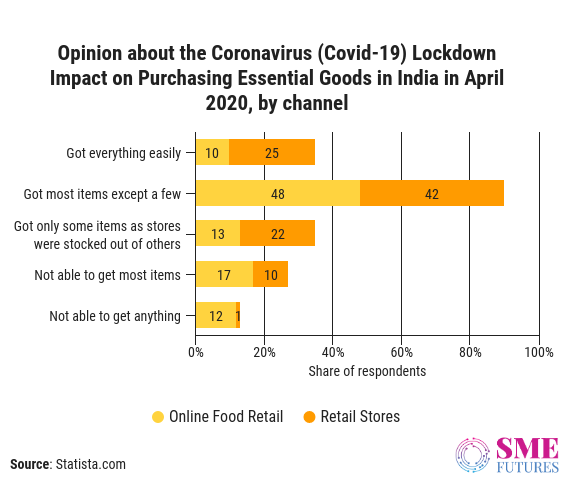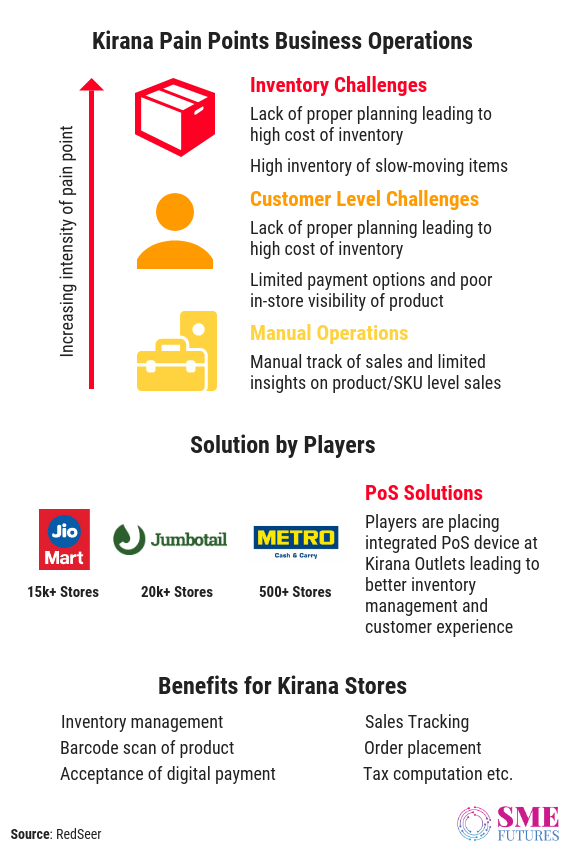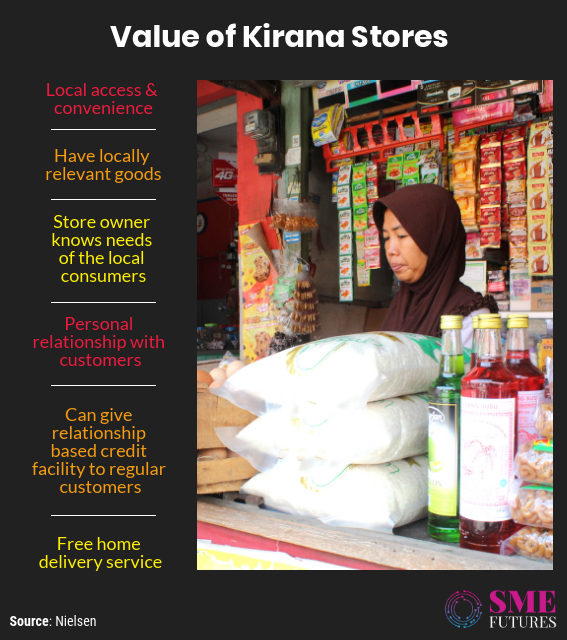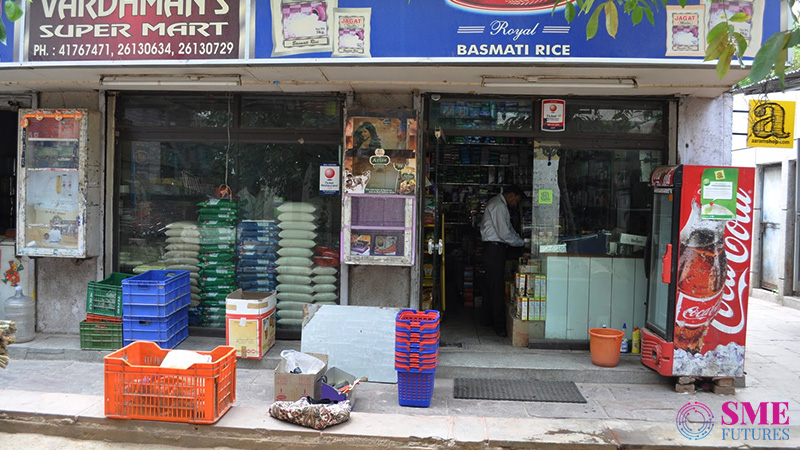India has entered lockdown 3.0, the coronavirus cases here have crossed 45000 mark with death toll rising over 1,500. And, if the ground report is anything to go by there are chances that the lockdown might continue further in metros such as Mumbai and Delhi. With almost 1.3 billion people quarantined for last 43 days, there is one set of business community that is up and running to provide essential services to Indians.
The Indian Kirana.
At a time when big retailers and e-commerce companies are facing prohibition on supplying non-essential products and services, the ubiquitous Indian kirana stores rolled up their sleeves, and are witnessing a surge in the sales of essential items. They are even finding it difficult to keep up with the rising demand.
Ghaziabad-based Arun Mittal, owner of Mittal Stores, has been “super busy” since lockdown, with sales shot up like never before. “Sales have been doubled. However, procurement issues remain a challenge, impacting order fulfilment.”
The government has imposed strict movement restriction directives. Shops supplying essential items like grocery, medicines have been exempted from the lockdown. Another grocery shop owner Rajesh Rajora, based out of Noida, informs that sales have increased to an extent that he had to call his supplier twice for refilling essentials in last one month.
“Earlier, it would be in months that refilling would be needed,” he tells us. He said within hours of opening his shop most items get sold out. “People now want to buy groceries only after seeing it with their own eyes. With online shopping, there is uncertainty and frequent cancellation due to which many people prefer buying it from small shops,” Rajora adds.
While Hari Singh, a kirana shop owner, was on the verge of shutting down his business this year, but the lockdown gave him a fresh lease of life. “I know many other businesses are going downhill but my business has been booming since the lockdown. I know I cannot offer the kind of discounts the online retailers offer but at least I am reliable,” he states.

Renaissance of Indian Kirana?
“Kirana stores were always essential to the Indian consumer and economy, but in Covid-19 scenario they have been rightly tagged as an ‘Essential Service’,” notes Sunil Khosla, President-digital business, India Transact Services, a digital payment company.
The brave act of working long hours, agility in time of need and consumer blessing proves the renaissance of these small-format stores – who are now becoming the saviour of the Indian consumers/household, he adds.
In retail, food and grocery accounts for the largest share in revenues in India and is estimated to account for around 66 per cent of total retail revenue by 2020. Majority of the grocery business happens through unorganized sector i.e the neighbourhood kirana stores.
According to research firm Red Seer, there are around 15 million kirana stores in the country; while a Nielsen report states the number to be nearly 12 million, which accounts for 90 per cent of domestic retail and FMCG sales. Around 8 per cent of retail sales come from the modern trade, while 2 per cent from e-commerce.
However, the modern retail – which is still at a nascent stage in terms of market share – is taking over the traditional mom and pop stores in urban areas.
A joint report by Red Seer and online grocery firm Big Basket revealed that online grocery segment has picked up pace as number of e-commerce users are growing, which has a steady effect on online grocery purchases.
The online retail is estimated to reach 1.2 per cent of the market by 2023 from a miniscule 0.2 per cent, the report stated.
It should be noted that online grocery startups account for 40 per cent of total e-commerce funding in India.

Also, the changing food consumption pattern and the entry of big retailers, the sector is witnessing a drastic shift. With touch-and-feel experience and all under one roof, retailers in malls and shopping centres are drawing away the consumers from the neighbourhood stores.
Having said that, JLL India feels kirana stores were always an important part of the retail ecosystem as most consumers use local and neighbourhood stores for top ups and specialty purchase.
Subhranshu Pani, MD (retail service), JLL India, expresses his views: “In the initial phase of hypermarkets coming up, there were pressures on the kirana stores, but they quickly found the balance and filled in the gap. And, by the virtue of knowing their consumers better, they sharpened their product and offerings.”
With Covid-19 outbreak, the kirana stores are once again turning the tables.
With the restrictions on travel and closure of mall and shopping complexes, kirana stores have gained immensely.
So, does this mean the coronavirus has brought good times for small retail businesses? Experts say yes, but for the time being.
According to Retailers Association of India (RAI) CEO Kumar Rajagopalan, availability of essentials is least impacted in the country – unlike the West where consumers are seen lining up before supermarkets in serpentine queues – because of kirana stores in every nook and corner.
“Kiranas have become the lifeline of this country,” he said.
Pani of JLL India believes that the Covid time has brought the kirana back into a sharp focus. “However, even for them, I see in the cities, general merchandise not being permitted and only groceries and vegetables being allowed.”
Similarly, Professor and founder at the Institute for Advanced Studies in Complex Choices (IASCC) Anil K Sood is also of the belief that it is indeed a better time than the kirana store owners have had for many years…though it has come at a time when people are struggling to lead a normal life.
“Covid-19 has brought the middle and upper-middle income customers to the kirana fold now as these customers don’t have access to organized retail as the e-commerce deliveries are also restricted,” Sood adds.
Several residential societies are getting into contract with their nearby kirana stores to supply the residents with daily needs. This arrangement helps both the buyers and the sellers.
Changing consumer behavior – an opportunity
Undoubtedly, consumer behaviour has changed.
Mittal of Mittal Stores says that people are buying more packaged products than ever.
“Packaged products such as pulses, rice, flour, noodles, biscuits are selling much faster that I cannot keep up the demand. Consumers are piling up.”
While the shop owner Rajora is witnessing people from all walks of life coming and buying essential items. “Even youngsters who were especially dependent upon e-retailers are coming to my shops,” he quips.
Consumer preferring packaged foods: As Covid-19 lockdown creates immense demand for processed, canned and frozen foods, a new report by ResearchAndMarkets.com states that packaged food market is set to rise by 377 per cent globally.
While prior to this, the growth rate of packaged food industry across India was estimated to be 16 percent from fiscal year 2015 to 2020, up from about 15.6 percent from fiscal year 2010 to fiscal year 2015, according to the research platform Statista.

Consumers are moving away from fresh foods, and stockpiling foods with a longer shelf life. Products that require little preparation such as ready meals and instant noodles are also seeing rising demand.
At the same time, packaged food and beverage companies such as Nestle India, Hindustan Unilever (HUL), Britannia, Dabur India, ITC and Emami have gained at the stock exchanges and are witnessing healthy demand for their products.
Nestle India market prices raised to 38 per cent since lockdown. As per analysts, it’s the only company in staple segment to report double-digit domestic sales growth in the recent quarters, despite demand slowdown.
Maggie and nutrition portfolio has given a robust growth.
In addition to this, retailers such as Future Retail, Walmart and Metro Cash & Carry have witnessed a spike in their private labels as supply lines from other manufacturers are disrupted amid the lockdown.
The retailers said their in-house brands in essential categories such as staples and food have witnessed over two-fold jump in sales during this period.

Seeing the opportunity, these brands are pushing their private labels to fill the gaps in supply chain. Also encouraged by the customers response, retailers are now extending their private labels in packed food and beverages.
Metro Cash & Carry India MD and CEO Arvind Mediratta said, “Our private label brands have witnessed encouraging growth in the past few weeks and yes we have been able to cater to our customer needs through our own brands.”
It has ramped up capacities in almost all essentials categories ranging from – pulses, flours, rice, oil amongst others, apart from other key categories in personal and home care products such as hand wash, sanitiser, and cleaners to ensure availability of stocks at its stores during the lockdown.
“Own brands under categories such as personal care, FMCG processed food, snacking, tea have grown over 100 per cent; and grocery such as rice, flour, oil over 150 per cent. Furthermore, we have seen our own brands gaining a share by almost over 1 per cent,” he added.
At the times when packaged foods are what consumers are choosing, another brand Madhur Sugar is running a campaign to reiterate how important it is to use the packaged products at times of contagion crisis.
“One can wash vegetables, pulses and rice, but sugar cannot be washed so ensuring you only bring home a trusted brand like Madhur is critical,” says the company’s president and business head Satbir Singh Sindhu.
“Through this campaign, we are trying to tell buyers that hygiene is the first step to health and safety. It is advisable to cut down purchase of loose staples like sugar completely and instantly graduate to Madhur sugar, which is completely untouched by hand,” he claims.
On the other hand, retail players like Future Group, Reliance, Flipkart have now realized that kirana stores could be their brand improving opportunity. Brands are planning to tie up with kirana stores as pick up points. This will give chance to consumers to take the deliveries whenever they are free.
#Digitising kirana stores: Today when everyone wants to stock their kitchens, ATMs have ambushed and can be seen with ‘no cash’ placards. With this, online wallets and digital money are powering majority of transactions currently.
India has recorded an accelerated growth rate of over 50 per cent in the volume of retail electronic payment transactions in the last four years, according to a report by the Reserve Bank of India (RBI). The growth in 2018-19 was largely due to the steep growth in Unified Payments Interface (UPI)-based digital payments.
As per the Assocham-PWC study, digital payments in India will more than double to US $ 135.2 billion in 2023 from US$ 64.8 billion this year with a compounded annual growth of 20.2 per cent.
And, spurt in smartphone users (the country has over 450 million smartphone users), digital payments and e-wallet companies are in for some fierce competition – as Facebook-owned WhatsApp Pay is all set for mass rollout.
“The next wave of growth and digitalization surely belongs to this elite yet humble group of entrepreneurs both in urban and rural markets. Consumer loyalty, along with increased delivery efficiency and social distancing norm from the kirana stores, will be the new norm,” said Khosla from India Transact.

Digital payments are tapping kirana stores like never before. For instance, Google Pay, which has 55 million monthly users in India, is eyeing on tapping ubiquitous kirana shops.
Ambarish Kenghe, director, product management, Google Pay India told IANS, “The idea is to empower more Indians as digital becomes new cash for millions in the country. UPI helps you pay at the neighbourhood kirana store and after leading the peer-to-peer (P2P) digital payments market, peer-to-merchant (P2M) market is we are currently looking into.”
Google Pay currently has over 3,000 online merchants, including Zomato, BookMyShow, Swiggy, RedBus and others, while it is accepted at over 200,000 offline stores across 3,500 towns and cities. Some of its big customers are Reliance Stores and Vishal Mega Mart, etc.
On the other hand, Paytm has also announced to partner with 10,000 kirana stores and small businesses for delivering grocery products across 100 cities.
The company has launched several initiatives to help stressed businesses including its merchant partners, small shop owners, SMEs during the Covid-19 pandemic crisis.
“Digitally enabling small businesses by selling on Paytm Mall and giving them all the necessary logistics support, the company hopes to help shops and stores which have either witnessed a sharp decline in footfall or had to abruptly pause operations due to the lockdown,” Paytm said in a statement.
In another development, Jio Mart – a new commerce platform of Reliance Industries – will be integrating small retailers and local merchants on its portal so that they can list their products and sell them.
The Mukesh Ambani-owned company Jio Mart said that it will empower nearly 3 crore small Indian kirana shops to digitally transact with every customer in their neighbourhood.
“This means all of you can order and get faster delivery of day-to-day items from nearby local shops. At the same time, small kiranas can grow their businesses and create new employment opportunities using digital technology,” Ambani said soon after the Jio-Facebook deal.
In addition to that, retail players are providing integrated PoS (point-of-sale) to kirana stores, which is helping them to track sales, manage inventory, drive customer insight and conduct proper product planning.

The growth of kirana – will this last for long?
Lockdown will at some point be lifted, hence experts strongly believe it’s a short term growth – and the chances are that consumers will go back to previous order of shopping behaviour.
As we know, the household purchasing and consumption behaviour does changes very slowly, which allows the retail business to be a steady state business. We also know that we need the consumption behaviour to change for purchasing behaviour to change.
“A family that is used to buying certain brands or goods or buying in bulk just once or twice a month will probably go back to organized retail as the next-door kirana store may not have the specific merchandise (e.g., non-seasonal fruits and vegetables) in required quantity,” Sood from IASCC said.
“In retail shopping, the ambience too matters. We need to see if the kirana stores will have enough capital to invest in creating an ambience, which similar to organized retail,” he argues.
Having said that, kirana stores are easy accessible (open for longer hours than organized retail in most cases), deliver at home at convenient time (saving the buyers time wasted in traffic or long queues at check-out counters) and, of course, friendly service where the buyer and sellers know that it a mutually beneficial long-term relationship (you don’t see new faces every time you walk into an organized retail shop).
“This will be a short-term growth,” believes Pani of JLL India. “However, the general belief is that because of the current situation and habit, most neighbourhoods will continue to favour or increase consumption from the local kirana.”
And, loyalty towards the neighbourhood kirana store will go up, he feels.
Pani points out that these new changes have the potential to change the game:
Amazon has come back and said it can have any store ready to be on their platform in 48 hours. There are platforms like Udaan which many kirana’s are now evaluating to be online even locally. And, Big Baskets, Amazon etc. are considering partnering local kirana for last mile delivery.
This means that some of these local kirana stores will now be app-enabled and go digital – that could change the dynamics of the industry and increase convenience of the customer.
In addition to this, Sood says he expects some consumers to start considering kirana stores as an alternative source for some purchases, but “it is unlikely that we will see a renaissance for kirana stores,” he thinks.
The future
Small stores will continue to be under pressure but will continue to evolve. Also, the higher rentals and cost structures will ensure that small stores will be a strong force.
E-commerce platforms and organized retail have started seeing the kirana stores as an important part of their supply-chain for reducing their investment in warehouses, inventory and logistics.
This is evident from the fact that there could be two strategies playing out in the market:
- Reliance/Dmart etc. are looking at local small store strategy to capture larger pie of the market and make sure they give more convenience to the operators
- Whole sellers like like Reliance, Walmart, and Metro etc. are serving these kirana stores, supplying them in bulk and letting them have the benefit of pricing and collective buying.
“This just means that as we evolve with hypermarkets, the small stores are evolving and will continue to be relevant and important,” expresses Pani.
On the other hand, experts opine that it depends on how the relationship between organized retail and small kirana stores evolve.
“As we know, the organized retail and e-commerce thrive on cashflows. Customers pay them in advance, and they pay the suppliers after 30-45-60-90 days, depending on the credit terms,” Sood informs.
“Organized retail and e-commerce expect to earn profits by building scale over time. We have seen them sacrifice profits for growth,” he adds.
Kirana store owners, on the other hand, will have to worry about margins as well as cash flows. They can’t afford to sacrifice margins for growth as they don’t have financial investors with deep pockets. They earn their living out of daily sales, and don’t have advantage of scale.
In the long run, the questions really are – Who is going to provide value to the consumer? What is the consumer willing to pay for that value? Who captures the profit arising in the complete value-chain?
Till, there is no concrete answer for these questions – the fate of Indian kirana remains blurred.











